Uzbekistan Ground Forces
| Uzbek Ground Forces | |
|---|---|
 Coat of Arms of the Republic of Uzbekistan | |
| Active | 1992 - present |
| Country | Uzbekistan |
| Branch | Army |
| Role | Defense of Uzbekistan |
| Size | 40,000 (est. 2006) |
| Garrison/HQ | Tashkent |
| Engagements | Tajik Civil War |
The Ground Forces are the land component of the Armed Forces of the Republic of Uzbekistan. Operating since the collapse of the Soviet Union in 1991, the army is made up of former Soviet Army units that were in the territory of Uzbekistan. As of 2006, it had around 40,000 active personnel. Much of the equipment it uses is also old Soviet material, and the government of Uzbekistan has not given much effort to replace it with modern equipment.[1]
History
The armed forces were created in 1992, and along with the army, the air and air defense forces, national guard, and border service were created. Islam Karimov, the President of Uzbekistan, had begun calling native Uzbeks in the Soviet Armed Forces back to Uzbekistan to fill the ranks of the newly created ground forces, though many refused to return and renounced their citizenship. Russians made up the majority of the officer corps, while the enlisted personnel were mainly Uzbek.
Uzbekistan then became the only Central Asian state that did not allow Russian Federation citizens to serve in the army, and began to replace the Slavic officers with ethnic Uzbeks. At independence, Slavic officers made up the command of the army, and thus an effort was made to give Uzbeks higher positions, giving Slavics lower ranks. The Slavs who stayed in Uzbekistan accepted Uzbek passports.
Three major military academies, the Tashkent Higher All-Arms Command School, Tashkent Higher Tank Command School, and Samarkand Higher Military Automobile Command School,were located in Uzbekistan. This caused the government to not send Uzbek officers to Russia for training. In 1994, they established the joint Armed Forces Academy, to train officers of all branches. Though the Uzbek language was becoming more in use by the army, Russian remained the main language used in training officers, due to the fact that most manuals were in Russian and that the Central Asian Turkic languages did not have proper military vocabulary.
In 1997, the United States CENTRASBAT program paid over $5 million to fund a training exercise between Uzbek and American troops that were going to be stationed in the country. Later in 1998, a US general attended a Uzbek base that had a unit which took part in the training. After asking for a show of hands of who took part in it, only two raised them. Most Uzbek soldiers leave the service when their mandatory conscription ends. The US forces have found this to be the case in Kyrgyzstan and Kazakhstan as well. The army was similarly run to the Soviet one, in terms of command, service, and equipment. Senior commanders gave strict orders that allowed little freedom of decision.
In 2003, the defense ministry announced that the conscription time was lowered from 18 months to 12, and those who attended officer schools only had to serve nine months. It was encouraging higher ranking personnel to serve longer. Many young Uzbeks bribed recruitment officials to not draft them into the army, as dedovshchina was widespread.[1]
Organization
The Army includes five military districts, the Northwest at Nukus, the Southwest special military district at Karshi, the central military district at Dzhizak, and the East military district at Ferghana. In 2001, the Tashkent garrison was transformed into the fifth MD - the Tashkent military district.[2]
The headquarters of the military districts and their areas of responsibility are confirmed. The subordinate brigades listed in the table below have been attributed to the various military districts either because they are located in the same city as the military district headquarters or are clearly within the military districts' area of responsibility - that is, the 37th Motor Rifle Brigade at Andijan.
| Formation | Headquarters Location | Notes |
|---|---|---|
| Northwest Military District | HQ Nukus | Karakalpakstan, Xorazm Province |
| ? Motor Rifle Brigade | Nukus | |
| Southwest Special Military District | HQ Karshi | Qashqadaryo Province, Surxondaryo Province, Bukhara Province, Navoiy Province |
| 25th Motor Rifle Brigade | Karshi (Nuristan) | SW MD, Military Unit No.08579 |
| Central Military District | HQ Dzhizak | Dzhizak Province, Samarqand Province, Sirdaryo Province |
| ? Artillery Brigade | Kattaqurgan, Samarqand | former 353 artillery bde |
| Eastern Military District(EMD) | Ferghana | Fergana Province, Andijan Province, Namangan Province |
| 17th Air Assault Brigade | Ferghana | EMD, up to 5000 soldiers- 4th airborne bde |
| 37th Motor Rifle Brigade | Andijan | EMD, referred to as 34th MR Bde[3] |
| ? Artillery Brigade/Regiment | Ferghana | EMD, Из 105th Guards Air Assault Division, Soviet Airborne Troops |
| Tashkent Military District | HQ Tashkent | Tashkent Province, Established 2001 |
| ? Artillery Brigade/Regiment | Tashkent | Probably training artillery regiment in Chirchik |
There are four motor rifle brigades whose designations are not known,[4] and the 17th Air Assault Brigade at Fergana, the former Soviet Airborne Forces' 387th Airborne Training Regiment. Motorized brigades are located around Bukhara, Samarqand, Termez, Nukus, and Andijan.[5]
Other Listed Formations
- 2 АК МС, Fergana, unit 49827, incl. 15 air assault bde, Chirchik training regiment and fergana airborne bde-1999[4]
- Motor Rifle Brigade, Chirchik, unit 16707
- Motor Rifle Brigade, Samarqand, former motor rifle division? (reserve)
- Motor Rifle Brigade, Termez, former 108 motor rifle bde
- Tank Regiment (тп), Used to be located in Navoi, transferred to Ahargaran
- Engineer bde
- SF Btn, Tashqent, former 459th SF coy
- National Guard bde, Tashqent,1000 soldiers- including security btn, ceremonial company and SF company.
Exercises

Uzbek troops participated in Partnership for Peace Exercise Cooperative Osprey '96 at Camp Lejeune in North Carolina, hosted by the United States Marine Corps. They then participated as well in Exercise Cooperative Osprey '98.
In September 2004, the (then) Royal Welsh Regiment (now 3rd Bn The Royal Welsh) of the British Army participated with the Uzbek Army Peacekeeping Battalion in "Exercise Timurlane Express" in the Farish Mountain Training Area. This was a 3-week NATO sponsored Partnership for Peace training exercise.
Current equipment
Reportedly, Uzbek armed forces' small arms include the AK-47, AK-74, Dragunov sniper rifle, Makarov PM pistol, and PK.
| Current equipment | ||||||||
|---|---|---|---|---|---|---|---|---|
| Name | Photo | Origin | Type | Quantity | ||||
| Small arms | ||||||||
| AK-47 |
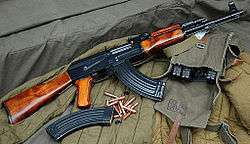 |
USSR | Assault rifle | |||||
| AKM |
 |
USSR | Assault rifle | |||||
| AK-74 |
 |
USSR | Assault rifle | |||||
| RPK |
 |
USSR | Squad automatic weapon | |||||
| PKM |
|
USSR | General purpose machine gun | |||||
| SVD |
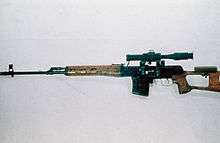 |
USSR | Designated marksman rifle | |||||
| Grenade launchers | ||||||||
| RPG-7 |
 |
USSR | Rocket-propelled launcher | |||||
| Tanks | ||||||||
| T-80 |
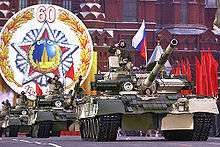 |
USSR | Main battle tank | 80 | ||||
| T-72 |
 |
USSR | Main battle tank | 70[6] | ||||
| T-64 |
 |
USSR | Main battle tank | 100[6] | ||||
| T-62 |
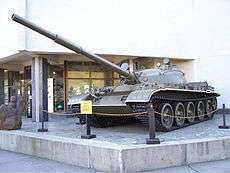 |
USSR | Main battle tank | 170[6] | ||||
| T-54 |
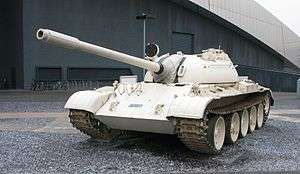 |
USSR | Main battle tank | 80[6] | ||||
| Infantry Fighting Vehicles | ||||||||
| BMP-1 |
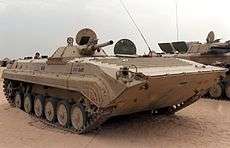 |
USSR | Infantry fighting vehicle | 180[6] | ||||
| BMP-2 |
.jpg) |
USSR | Infantry fighting vehicle | 270[6] | ||||
| BMD-1 |
 |
USSR | Infantry fighting vehicle | 120[6] | ||||
| BMD-2 |
 |
Russia | Infantry fighting vehicle | 9[6] | ||||
| M-ATV |
 |
United States | Infantry fighting vehicle | 308[7][8] | ||||
| Personnel carriers | ||||||||
| BTR-60 |
 |
USSR | Armoured personnel carrier | 24[6] | ||||
| BTR-70 |
_(262-6).jpg) |
USSR | Armoured personnel carrier | 25[6] | ||||
| BTR-80 |
.jpg) |
USSR | Armoured personnel carrier | 210[6] | ||||
| BTR-D |
 |
USSR | Armoured personnel carrier | 50[6] | ||||
| BRM-1K |
.jpg) |
USSR | Armoured personnel carrier | 6[6] | ||||
| BRDM-2 |
|
USSR | Armoured personnel carrier | 13[6] | ||||
| Rocket artillery | ||||||||
| BM-21 Grad |
|
USSR | 122mm Multiple Rocket Launcher | 50[6] | ||||
| BM-27 Uragan |
 |
USSR | 220mm Multiple Rocket Launcher | 48[6] | ||||
| Tactical ballistic missile systems | ||||||||
| Tochka |
|
USSR | Tactical ballistic missile | 5[6] | ||||
| HQ-9 |
 |
China | Tactical ballistic missile | 1[9] | ||||
| Self-propelled artillery | ||||||||
| 2S1 Gvozdika |
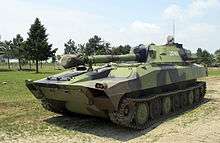 |
USSR | 122mm Self-Propelled Howitzer | 18[6] | ||||
| 2S9 Nona |
 |
USSR | Self-Propelled 120 mm Mortar | 54[6] | ||||
| 2S5 Giatsint-S |
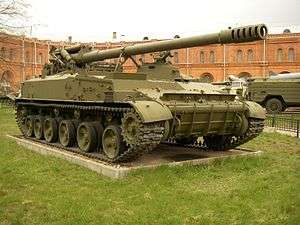 |
USSR | 152mm Self-Propelled Howitze | 17[6] | ||||
| 2S7 Pion |
 |
USSR | 203mm Self-Propelled Howitzer | 48[6] | ||||
References
- 1 2
- ↑ Bakhtiyar Kamilov, Formation of Conceptual Approaches to the Problems of Ensuring National Security in Central Asian States - Uzbekistan, Kazakhstan, Kyrgyzstan, Tajikistan and Turkmenistan
- ↑ Press-service of the President of the Republic of Uzbekistan: Islam Karimov: no one can turn us from our chosen path
- 1 2 http://www8.brinkster.com/vad777/sng/uzbekistan.htm, accessed late September 2007 and June 2010
- ↑ http://www.silkroadstudies.org/new/docs/CEF/Quarterly/February_2007/Burnashev_Chernykh.pdf
- 1 2 3 4 5 6 7 8 9 10 11 12 13 14 15 16 17 18 19 20 21 [↑ The International Institute For Strategic Studies IISS The Military Balance 2010. — Nuffield Press, 2010. — С. 373. — ISBN 978-1-85743-557-3.]
- ↑ the-military-balance-2016 —
- ↑ Пентагон завершит поставки Узбекистану бронетехники в ближайшее время — 12news.uz, 15.06.2015
- ↑ thediplomat.com